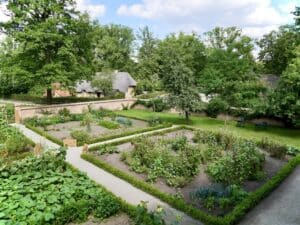Growing Hedges? The Ultimate Garden Guide

Hedges are one of the most popular plants to grow in Australia. They are hardy, elegant plants that suit a wide range of garden styles. They can create natural barriers within your garden design, and provide dappled light and privacy when used as screening plants.
There are a huge variety of plants that can be classified as hedges, so we’ve broken this guide up into two sections. First, we’ll talk about some general wisdom to follow when it comes to planting and caring for your hedges.
Afterwards, we’ll show you how to grow and care for 3 of the most popular types of hedging plants: Leighton’s Green, Syzygium Backyard Bliss and Ficus Flash.
Choosing hedges for your garden.
When choosing a hedge, the best place to start is to narrow down what you want, as there are many different varieties available. Here are the three most common reasons why our customers ask us for hedging plants:
Privacy. Hedges are known for their excellent privacy screening qualities. For perfect privacy, you want to look for a hardy plant that can grow dense foliage quickly. Popular privacy hedges include Photinia Robusta and Leighton Green.
Topiaries Other hedges are prized for their compact size and easy-to-style foliage. Topiary is the art of styling your hedges into defined shapes. These can be elegant and ornamental or totally surreal and fun! Japanese Box (Buxus) is popular.
Backdrops. Hedges can also make great backdrops for your garden beds. If you’re looking for a bold red colour to contrast with, try Acmena plants. Otherwise, there are a wide variety of beautiful flowering hedges, like Camellia Japonica.
It’s also worth being totally honest with yourself about how much time and effort you think you’ll be able to put into your hedge. If you’re an infrequent gardener or you have poor soil, choosing the more durable hedges can be a good idea. Australian native hedges and Cyprus are particularly tolerant of harsh conditions.
Planting a Hedge
Before planting your hedge, it’s good to prepare your soil. While most hedges can tolerate poor soil conditions, it’s important that they have good drainage. Creating a nutrient-rich environment will also give them the best chance of flourishing.
If your soil is poor, add your favourite fertiliser and some compost or manure, then work thoroughly through the top layer of your soil to ensure it isn’t too tightly packed. For best results, do this up to a week before planting your hedge to let the nutrients fully absorb into the soil and begin to repair it.
The size of the hole you need to dig will depend on different hedge species, the maturity of your plant, and their root systems. For your average hedge, dig to a depth of around 30cm. If your plant still seems too young and small for this, then dig it to the same depth as the pot it came in.
Spacing your Hedges
Spacing is an important factor when growing hedges, as it will affect both the density and the height of the foliage. In most cases, it is recommended that you follow a 3:1 ratio when spacing. Figure out your desired height and then space them at ⅓ of that. So for a hedge height of 1.5 metres, you’d want to space plants around 50cm apart.
It’s also a good idea to research the specific plant you are buying, as different plants may have slightly different requirements. In general, planting closer will give you a thicker hedge in much less time. If you’re growing a low dense hedge as an edging plant or topiary, this is a good strategy.
However, privacy hedges or screening plants may not reach their desired height when planted too closely together. The roots will start to compete for nutrients and space, and foliage may become tangled and dense, leading to poor results.
If you’re aiming for a tall hedge and you have a bit of patience, you can try planting further away to give your plants room to achieve their maximum height. The exact measurements will depend on the type of plant you are growing, but you can apply this way of thinking when spacing most popular hedge varieties.
Pruning and Training Hedges
Trimming is one of the most important things that you can do for your hedge Proper pruning technique is essential when you are first establishing and training your hedging plant.
Hedges will require regular maintenance to keep healthy and grow their foliage in the desired shape. For the best results, here are our top tips for pruning your hedges:
- Leave the sides at first. For newly established hedges, it’s good to start training them early. Keep the tops cut back below your desired level at first, to promote more growth around the sides, resulting in a thicker and healthier hedge. Let it grow upwards only once it has thickened out more.
- Trim in a wedge shape. You need to focus on more than just the outside foliage of your plant to grow a successful hedge. Taper hedges slightly so that they are thinner on top and thicker below. It will help sunlight reach all of the leaves more evenly, from the top to the bottom.
- Don’t prune flower buds. For flowering shrubs, you need to mind the buds during their flowering season – usually around Spring. You need to prune before the buds form or wait for flowering to stop, otherwise, you may damage their ability to bloom. You should only prune 3-4 times a year, so keep this in mind when planning a cutback.
- Prune low branches. It’s good to prune back decisively on thick, low-hanging branches below your desired foliage level. This will promote thicker foliage growth by redirecting more energy and proteins to the part of the hedge you are growing.
- Prune dead branches. If you notice dead branches inside your hedge, cut them back and remove them. This will allow more light to filter through your plant and make room for healthy new growth, to replace dead or dying sections.
- Detailing the top and edges. Hard edges are visually appealing on a hedge plant. You can use string or wire to help plan out straight edges in advance. Always trim the top of your hedge last to minimise harm. You should consider investing in some topiary shears if you decide to craft a particularly complex topiary shape.
- Fertilise afterwards. Pruning can be a bit of a stressful experience for your plants, so it’s a good idea to add some extra nutrients into the soil to help your plant recover. Hedges that are still being established can often be a bit sensitive, so use something gentle like organic compost or a slow-release fertiliser.
Following these 7 tips will help you to grow a healthier, happier hedge. However, there is no perfect strategy for every single plant, so remember to always research the specific plant that you are bringing home. You can always ask us for more specific gardening advice.
How to Grow 3 Popular Hedging Plants:
These 3 hedges are some of the most popularly used in Australian gardens. They’re relatively easy to grow and provide great results as natural boundaries or privacy screens.
Each of these popular hedge breeds originates from a broader family of plants, many of which also make excellent hedging plants. Alongside some care tips, we’ll also talk a little bit about other common varieties from these different hedge types.
Leightons Green (Cyprus)
Plants from the Cyprus family make for great hedges, and Leighton Green (Cupressocyparis Leylandii) is perhaps the most popular variety. You’ll see this hedging plant in gardens all over Melbourne, particularly in the leafy eastern suburbs.
Cyprus trees and shrubs are sought out as ideal hedges because of their super-fast growth, thick evergreen foliage and subtly deep colour tones. They are coniferous and low maintenance, with their height and hardiness making them popular as windbreaks.
Other popular Cyprus varieties for hedging include Lemon Aroma, Castlewellan Gold, Glabra Arctic and the Glauca Pencil Pine.
Caring for Leighton Green: These are very hardy trees that will survive frost and strong winds better than the other hedge varieties on this list – they’ll even withstand a harsh coastal wind! Position in full sun or partial shade in fertile, well-drained soil. Leighton Green will tolerate long periods of drought but performs best when watered regularly.
This fast-growing plant is tall and wide, so you will want to space them at least 2m apart for a high-growing hedge. It can grow up to 3m in the first 18 months! To grow a row of full-sized trees (like on a rural property) you may want to space at least 5m apart. Mulch well and fertilise with a slow-release fertiliser every few months. Prune hard as needed.
Backyard Bliss (Syzygium)
A popular new variety of Lilly Pilly, Backyard Bliss is resistant to the psyllid pests that plague other Lilly Pilly plants. This fast-growing Australian Native has beautiful white flowers and tasty purple berries. When planted alongside a path, this plant can add a whimsical fairytale feel to your garden. It’s also a dense and drought-hardy plant that is very easy to grow, making it ideal for hedging.
Similar plants to Backyard Bliss include Lilly Pilly, Sublime, Cherry Surprise, Forest Flame and Little Ruby. These are all Acmena hedges, renowned for their robust hardiness and the strong colouring of their leaves, which can change dramatically throughout the seasons.
Caring for Backyard Bliss: As a tough Australian native, Backyard Bliss should survive in most soils (including sandy soils) provided there is some good drainage. It will do best in fertile loamy soil. This plant will struggle if it is sitting in soggy soil, so water semi-regularly during Winter and be careful not to overdo it. However, it will require more moisture and regular watering in the warmer Summer months. Fertilise annually with a slow-release fertiliser.
Plant in full sun or part shade position, preferably somewhere sheltered from harsh winds and frosts. Place between 50cm and 1m apart for hedging, depending on the desired height. Fertilise annually and mulch well. This plant can tolerate lots of pruning so don’t be afraid to go hard if necessary! The best time to prune is in late winter, before new growth begins.
Ficus Flash (Ficus)
Ficus trees – or Fig Trees – are a diverse species of plant native to tropical and temperate regions. Ficus Flash is one of the most popular plants available for hedging and they thrive in our climate. Flash is a newer and native variety of Ficus Hilli, with a much less invasive root system. It can be planted in bulk as a hedge or grown well in a container or pot.
Known for its stunning glossy green foliage, compact leaves and quick vertical growth, this plant is also very low-maintenance and highly tolerant of poor conditions. Other popular Ficus hedges include the Ficus Benjamina or Weeping Fig.
Caring for a Ficus Flash: This hardy plant will grow in almost any soil, including clay or sandy soils, but it prefers moist loamy soil with good drainage. Place in a partly shaded position as the leaves may burn in full sun. This plant is not tolerant of frost and will also survive well as an indoor plant. Water regularly, although Ficus is very tolerant of dry spells.
Ficus trees in general are known for having very aggressive root systems, and while the Flash is an improvement on other varieties, you should still take care when placing these near other plants. Ficus can be comfortably kept at around 3m high and 1.5m wide, but if left to grow it can reach 10m in height! For best results, prune back hard in late Winter and add a slow-release fertilise in early Spring. Shape regularly as needed.
Get started today on growing your hedge today at one of our Diaco’s Garden Centres or our Online Garden Store.
Don’t be afraid to ask our friendly team if you have any specific questions about hedging, especially if you are planning any large-scale landscaping. We are more than happy to offer our extensive expertise and provide quotes on bulk orders and delivery.
-
 13, Jun, 2025
13, Jun, 2025How to Start a Garden Design Project: Step-by-Step Planning Guide for Beginners
At Diaco’s, we know that creating a beautiful garden starts... -
 27, May, 2025
27, May, 2025Smart Garden Layout Ideas: How to Maximise Your Outdoor Space
At Diaco’s, we believe every garden has potential. Whether you’ve... -
 9, May, 2025
9, May, 20257 Garden Design Principles to Transform Your Outdoor Space
At Diaco’s, we know that creating a garden isn’t just...


